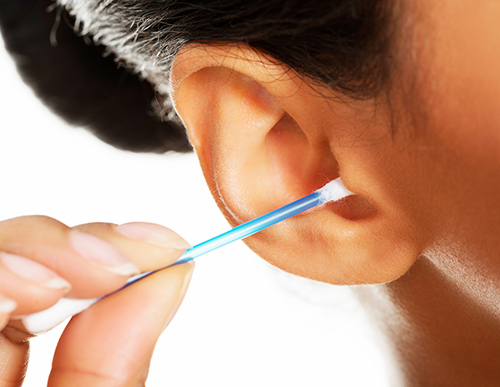
Why are so many people still using swabs to clean the ear wax out of their ear canals—especially when there’s a warning on that box of swabs, instructions from your hearing care professional, guidelines from the American Academy of Otolaryngology-Head and Neck Surgery (AAO-HNS) and that insistence from your grandma never to stick anything smaller than your elbow into your ear? Instead of removing that helpful ear wax, here’s 5 reasons you should leave it right where it is:
1. Ear Wax’s Job? Keeping Your Ears Clean
Most of your ear cleaning efforts are actually redundant. Cerumen (the scientific term for ear wax) is especially formulated by your own ears to help keep them clean. Cerumen traps stray dirt, dust and debris, stopping it before it can go deeper into your ear canal where it doesn’t belong. As you go throughout your day talking, chewing and yawning, these motions usher the soiled ear wax down and out of the ear canal where you can easily wipe it away with a washcloth during your shower.
Trying to remove ear wax from the ear canal with a swab, fork, key, pencil, chopstick, finger, etc. actually interrupts your ears’ self-cleaning process and shoves dirty cerumen further down the ear canal where it can get impacted and clogged against your ear drum. Nobody wants that.
2. Ear Wax Keeps Your Ears Safe
In addition to keeping dirt out of your ear canal, cerumen has, even more, benefits for your ears. Glands lining the inside of your ear canal whip a unique combination of cholesterol, enzymes, long-chain fatty acids, alcohols, sebum, sloughed off skin cells and other chemicals: This special recipe does a lot of important things that should make you want to leave your ear wax in your ears:
Repelling insects; bugs find the smell of ear wax unpleasant, so they avoid flying into your ears.
Cerumen’s chemical composition, which is also slightly acidic for most people, inhibits the growth of viruses, bacteria and fungal infections.
Moisturizes and lubricates the ear canal, keeping it soft and healthy
For most people, cerumen is slightly acidic—a helpful property that hinders bacterial and fungal infections from taking hold inside your ears. Thanks again, ear wax!
3. Ear Wax Removal Harms Hearing
You may already have sustained some level of hearing loss, just from the process of swab-based ear wax removal habits. This type of ear wax removal actually shoves soiled, old ear wax further down into the ear canal where it can become impacted and cause hearing loss. If you’ve been doing this for years, schedule an appointment with your hearing care professional to have them check whether you have impacted ear wax that might be causing some amount of hearing loss.
Now, you may be one of those people who actually do have a problem with ear wax (beyond just wanting it gone). Some people make too much, while others don’t make enough. Occasionally, it may be too wet, too dry or not have the right balance of ingredients to get the job done right. Nevertheless, you still shouldn’t try to remedy or clean it out yourself with a swab or anything else (smaller than your elbow). If you’re worried about the health of your ear wax, please get in touch with your hearing care professional for an evaluation.
Wearing hearing aids can also be a bit problematic for ear wax, but if you follow your hearing care professional’s instructions on proper hearing aid cleaning and gently washing out your ears (no swabs or pointy things), you should be able to prevent excess ear wax from blunting the operation of your hearing aids, or from having ear wax impaction problems.
4. Avoid Ear Cleaning Accidents in Your Family
But sadly, they happen all too often. About 12,500 kids all across America end up in the doctor’s office each year with ear cleaning injuries like torn tympanic membrane (ear drum) or cuts and lacerations inside the ear canal. Unfortunately, these accidents can cause hearing loss, particularly during a developmentally important time in life. Aggressive ear cleaning with pointy objects is something the whole family could do without.
And if you were just about to ask about “ear candling”, we have some advice about that too: don’t do it. Nobody really knows where the idea came from, but it’s been around for a long time, perpetuated by natural health enthusiasts as a “natural way to remove ear wax”. But now that you know that your ears need that ear wax, why would you want to stick a flaming hollow tube up your ear canal? Sounds like a bad idea because it is. Here’s what you need to know:
- It’s been proven ineffective for ear cleaning and can actually make ear wax impaction worse.
- It causes burn injuries to the face, ears, hair, etc. – even burns that go all the way to the ear drum and middle ear.
- It’s also been known to puncture the ear drum.
So please… just don’t do it.
5. This is the Right Ear Cleaning Method for All:
Just hop in the shower and get clean. While you’re doing that, just gently wipe around the outside of your ears (front and back), but don’t jam the washcloth into your ear canal. This should just remove the already expelled ear wax that has completed its cleaning duties. When you’re done, just towel off the excess water and you’re finished. You don’t need to (and shouldn’t) follow up with swabs in the ears unless you only swab around the very outside of them—never inside the ear canal! The ear wax inside is still doing its important work.
If you have any concerns about your ear wax, your hearing, ear wax removal, ear cleaning habits or anything else associated with your ears, schedule an appointment with your hearing care professional today—and be grateful for your wonderful ear wax!